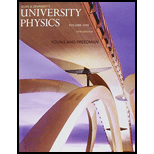
Concept explainers
To explain: The possibility for the existence of antiatoms in some part of the universe, their detection, and the problems might arise if we actually did go there.
Answer to Problem 44.1DQ
There is possibility for the existence of antiatoms in the universe and their detection is not possible since their spectra will be the same as that of corresponding matter and the matter antimatter annihilation will result the destruction of our body if we actually go to a region of antimatter.
Explanation of Solution
The antiparticles bind with one another to form antimatter as exactly same as the ordinary particle bind to form the matter. If a positron and an antiproton bind together, the result will be an antihydrogen which can be considered the smallest antiatom. The physical principles indicate that in the universe, complex antimatter atomic nuclei composed of antiprotons and antineutrons are possible, as well as when they surrounded by positrons, the existence of antiatoms corresponding to the known chemical elements is also possible.
A specific method for the detection of the antimatter is not known since, if the neutral antiatoms do exist, their behavior will be exactly same as the normal atoms. So any spectra of an atom that given by the light that emit which composed of photons will be the same as the spectra that given by the antiatom, which composed of antiphotons. This is only because photon is its own antiparticle. So we cannot detect the antiatoms by identifying the light they emit as composed of antiphotons. The only way to identify the presence of antimatter is through their annihilation with matter. If we actually did go to the antimatter region the problem that might occur is that the annihilation of matter in our body with the antimatter in that region and thereby the complete destruction of our body.
Conclusion:
Thus, there is possibility for the existence of antiatoms in the universe and their detection is not possible since their spectra will be the same as that of corresponding matter and the matter antimatter annihilation will result the destruction of our body if we actually go to a region of antimatter.
Want to see more full solutions like this?
Chapter 44 Solutions
University Physics with Modern Physics, Volume 1 (Chs. 1-20) (14th Edition)
- 1. An arrangement of three charges is shown below where q₁ = 1.6 × 10-19 C, q2 = -1.6×10-19 C, and q3 3.2 x 10-19 C. 2 cm Y 93 92 91 X 3 cm (a) Calculate the magnitude and direction of the net force on q₁. (b) Sketch the direction of the forces on qiarrow_forward(Figure 1)In each case let w be the weight of the suspended crate full of priceless art objects. The strut is uniform and also has weight w Find the direction of the force exerted on the strut by the pivot in the arrangement (a). Express your answer in degrees. Find the tension Tb in the cable in the arrangement (b). Express your answer in terms of w. Find the magnitude of the force exerted on the strut by the pivot in the arrangement (b). Express your answer in terms of w.arrow_forward(Figure 1)In each case let ww be the weight of the suspended crate full of priceless art objects. The strut is uniform and also has weight w. Find the direction of the force exerted on the strut by the pivot in the arrangement (b). Express your answer in degrees.arrow_forward
- A 70.0 cm, uniform, 40.0 N shelf is supported horizontally by two vertical wires attached to the sloping ceiling (Figure 1). A very small 20.0 N tool is placed on the shelf midway between the points where the wires are attached to it. Find the tension in the left-hand wire. Express your answer with the appropriate units.arrow_forwardFind the total bind Mev. binding energy for 13 Carbon, 6C (atomic mass = 13.0033554)arrow_forwardWhat is the 27 energy absorbed in this endothermic Auclear reaction 2] Al + 'n → 27 Mg + ! H? (The atom mass of "Al is 26.981539u. and that of 11 Mg is 26.984341u) MeVarrow_forward
- What is the energy released in this nuclear reaction 1 F + "', H-1 O+ He? 19 19 16 (The atomic mass of 1F is 18.998403 u, and that of 20 is 15.9949154) MeV.arrow_forwardWhat is the energy released in this B+ nuclear reaction خالد 2½ Al w/ Mg + ie? (The atomic mass of 11 Al is 23.9999394 and that > of 12 Mg is 23.985041 u) MeV.arrow_forwardWhat is the energy released / absorbed in this nuclear reaction 14 N+ & He → » O + ! N? (The atomic mass of 14 N is 14.003074u. 17N+ and that of 10 is 16.9991324). MeVarrow_forward
- Can someone help me answer this question thanks.arrow_forwardCan someone help me with this question thanks.arrow_forward4B. Four electrons are located on the corners of a square, one on each corner, with the sides of the square being 25 cm long. a) Draw a sketch of the scenario and use your sketch to b) Determine the total force (magnitude and direction) on one of the electrons from the other three?arrow_forward
 Principles of Physics: A Calculus-Based TextPhysicsISBN:9781133104261Author:Raymond A. Serway, John W. JewettPublisher:Cengage Learning
Principles of Physics: A Calculus-Based TextPhysicsISBN:9781133104261Author:Raymond A. Serway, John W. JewettPublisher:Cengage Learning Modern PhysicsPhysicsISBN:9781111794378Author:Raymond A. Serway, Clement J. Moses, Curt A. MoyerPublisher:Cengage Learning
Modern PhysicsPhysicsISBN:9781111794378Author:Raymond A. Serway, Clement J. Moses, Curt A. MoyerPublisher:Cengage Learning College PhysicsPhysicsISBN:9781938168000Author:Paul Peter Urone, Roger HinrichsPublisher:OpenStax College
College PhysicsPhysicsISBN:9781938168000Author:Paul Peter Urone, Roger HinrichsPublisher:OpenStax College University Physics Volume 3PhysicsISBN:9781938168185Author:William Moebs, Jeff SannyPublisher:OpenStax
University Physics Volume 3PhysicsISBN:9781938168185Author:William Moebs, Jeff SannyPublisher:OpenStax Physics for Scientists and Engineers with Modern ...PhysicsISBN:9781337553292Author:Raymond A. Serway, John W. JewettPublisher:Cengage Learning
Physics for Scientists and Engineers with Modern ...PhysicsISBN:9781337553292Author:Raymond A. Serway, John W. JewettPublisher:Cengage Learning





